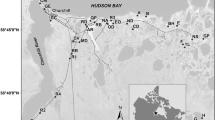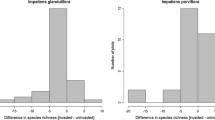Abstract
Past land uses by humans can have long-term effects on natural communities. To test the hypothesis that past land use can alter patterns of biological invasion for extended times, we predicted that middens abandoned by Native Americans over a century ago would have high abundances of introduced plants. We measured cover of vascular species and soil characteristics on and off the eight remaining middens in grasslands along 20 km of the northern coast of California. Relative cover of introduced plants was about 20% higher on than off middens, and cover of introduced annuals was about 110% higher. Concentration of inorganic N in the upper soil was twice as high on as off middens and explained about 40% of the variation in cover of introduced annuals. Abundance of shells on middens was correlated with inorganic N, suggesting that present invasion was linked to intensity of past land use. Results confirm that ancient land use by Native Americans is associated with present-day invasion by introduced plants and suggest that persistent elevation of soil N is partly responsible. Land use that elevates nutrient levels may promote invasion far into the future.





Similar content being viewed by others
References
Alpert P (2006) Sweet success: adding carbon to counter invasions by plants. Ecol Based Invasive Plants Manag 2:2–4
Alpert P, Bone E, Holzapfel C (2000) Invasiveness, invasibility, and the role of environmental stress in the spread of non-native plants. Perspect Plant Ecol Evol Syst 3:52–66
Alvarez SH, Fredrickson DA (1989) Critical Resources Inventory, Sonoma Coast State Beach from Goat Rock to Bodega Head, Sonoma County. California. Report to the California Department of Parks and Recreation, Sacramento, California
Braje TJ, Erlandson JM, Rick TC, Dayton PK, Hatch MBA (2009) Fishing from past to present: continuity and resilience of red abalone fisheries on the Channel Islands, California. Ecol Appl 19:906–919
Corbin JD, D’Antonio CM (2004) Competition between native perennial and exotic annual grasses: implications for an historical invasion. Ecology 85:1273–1283
Cox RD, Allen EB (2008) Stability of exotic annual grasses following restoration efforts in southern California coastal sage scrub. J Appl Ecol 45:495–504
Dambrine E, Dupouey JL, Laut L, Humbert L, Thinon M, Beaufils T, Richard H (2007) Present forest biodiversity patterns in France related to former Roman agriculture. Ecology 88:1430–1439
DeGasperis BG, Motzkin G (2007) Windows of opportunity: historical and ecological controls on Berberis thunbergii invasions. Ecology 88:3115–3125
Diedrich CG (2006) Discoveries of Neolithic prehistoric sites at Pleistocene carbonate rock shelters on the east coast of the UAE. Arab Archaeol Epigr 17:131–138
Erlandson JM, Braje TJ, Rick TC, Peterson J (2005) Beads, bivalves, and boats: an early maritime adaptation on the south coast of San Miguel Island, California. Am Anthropol 107:677–683
Flinn KM, Marks PL (2007) Agricultural legacies in forest environments: tree communities, soil properties, and light availability. Ecol Appl 17:452–463
Fraterrigo J, Turner M, Pearson S, Dixon P (2005) Effects of past land use on spatial heterogeneity of soil nutrients in southern appalachian forests. Ecol Monogr 75:215–230
Gea-Izquierdo G, Gennet S, Bartolome JW (2007) Assessing plant-nutrient relationships in highly invaded Californian grasslands using non-normal probability distributions. Appl Veg Sci 10:343–350
Heady HF, Foin TC, Hektner MM, Taylor DW, Barbour MG, Barry WJ (1995) Coastal prairie and northern coastal scrub. In: Barbour MG, Major J (eds) Terrestrial vegetation of California. Wiley, New York, pp 733–759
Hickman JC (ed) (1993) The Jepson manual: higher plants of California. University of California Press, Berkeley
Kelly L (2006) The vascular flora of Huggins Island, Onslow County, North Carolina. Castanea 71:295–311
Kennedy M (2004) An investigation of hunter-gatherer shellfish foraging practices. PhD Dissertation, Anthropology, University of California, Davis
King SM (2008) The spatial organization of food sharing in Early Postclassic households: an application of soil chemistry in Ancient Oaxaca, Mexico. J Archaeol Sci 35:1224–1239
Kolb A, Alpert P, Enters D, Holzapfel C (2002) Patterns of invasion within a grassland community. J Ecol 90:871–881
Kulmatiski A, Beard KH, Stark JM (2006) Soil history as a primary control on plant invasion in abandoned agricultural fields. J Appl Ecol 43:868–876
Mensing S, Byrne R (1999) Invasion of Mediterranean weeds into California before 1769. Fremontia 27:6–9
Miller VC (1990) Soil survey of Sonoma County, California. Soil Conservation Service, US Department of Agriculture in cooperation with the University of California Agricultural Experiment Station, Washington, DC
Moyes AB, Witter MS, Gamon JA (2005) Restoration of native perennials in a California annual grassland after prescribed spring burning and solarization. Restor Ecol 13:659–666
Parks CG, Radosevich SR, Endress BA, Naylor BJ, Anzinger D, Rew LJ, Maxwell BD, Dwire KA (2005) Natural and land-use history of the northwest mountain ecoregions (USA) in relation to patterns of plant invasions. Perspect Plant Ecol Evol Syst 7:137–158
Quinn L, Holt J (2008) Ecological correlates of invasion by Arundo donax in three southern California riparian habitats. Biol Invasions 10:591–601
Renne IJ, Tracy BF, Colonna IA (2006) Shifts in grassland invasibility: effects of soil resources, disturbance, composition, and invader size. Ecology 87:2264–2277
Rosendahl D, Ulm S, Weisler MI (2007) Using foraminifera to distinguish between natural and cultural shell deposits in coastal eastern Australia. J Archaeol Sci 34:1584–1593
Seabloom EW, Harpole WS, Reichman OJ, Tilman D (2003) Invasion, competitive dominance, and resource use by exotic and native California grassland species. Proc Nat Acad Sci 100:13384–13389
Seabloom EW, Williams JW, Slayback D, Stoms DM, Viers JH, Dobson AP (2006) Human impacts, plant invasion, and imperiled plant species in California. Ecol Appl 16:1338–1350
Sokal RR, Rohlf FJ (1995) Biometry: the principles and practice of statistics in biological research, 3rd edn. WH Freeman and Co., New York
Spiegelberger T, Hegg O, Matthies D, Hedlund K, Schaffner U (2006) Long-term effects of short-term perturbation in a subalpine grassland. Ecology 87:1939–1944
Stalter R, Kincaid D (2004) The vascular flora of five Florida shell middens. J Torrey Bot Soc 131:93–103
Stattegger K, Caldas L, Vital H (2006) Holocene coastal evolution of the Northern Rio Grande do Norte coast, NE Brazil. J Coastal Res 1:151–156
Tonner TWW (2005) Later stone age shellfishing behaviour at Duriefield Midden (Western Cape, South Africa). J Archaeol Sci 32:1390–1407
Van der Schriek T, Passmore DG, Stevenson AC, Rolao J (2007) The paleogeography of mesolithic settlement-subsistence and shell midden formation in the Muge valley, lower Tagus Basin, Portugal. Holocene 17:369–385
Vellend M, Verheyen K, Flinn KM, Jacquemyn H, Kolb A, Van Calster H, Peterken G, Graae BJ, Bellemare J, Honnay O, Brunet J, Wulf M, Gerhard F, Hermy M (2007) Homogenization of forest plant communities and weakening of species-environment relationships via agricultural land use. J Ecol 95:565–573
Whitaker AR (2008) Incipient aquaculture in prehistoric California? Long-term productivity and sustainability vs. immediate returns for the harvest of marine invertebrates. J Archaeol Sci 35:1114–1123
Acknowledgments
We thank Claudia Luke, Brendan O’Neil, Breck Parkman, Jackie Sones, the California State Parks, and the University of California Bodega Marine Reserve for help locating middens and for access to study sites; Albert Carranza, Taraneh Emam, and Susan Williams for help and facilities for soil analyses; Peter Connors for help with plant identification; and two anonymous reviewers for comments. Research was supported by USDA grants CREES 2001-35320-10629 and 2006-34439-17024, by the National Science Foundation Research Experiences for Undergraduates Program at Bodega Marine Laboratory, and by a Torrey Scholarship from the Plant Biology Graduate Program at the University of Massachusetts—Amherst. This is contribution 2465 from the University of California Bodega Marine Laboratory.
Author information
Authors and Affiliations
Corresponding author
Rights and permissions
About this article
Cite this article
Karalius, T., Alpert, P. High abundance of introduced plants on ancient Native American middens. Biol Invasions 12, 1125–1132 (2010). https://doi.org/10.1007/s10530-009-9530-4
Received:
Accepted:
Published:
Issue Date:
DOI: https://doi.org/10.1007/s10530-009-9530-4




